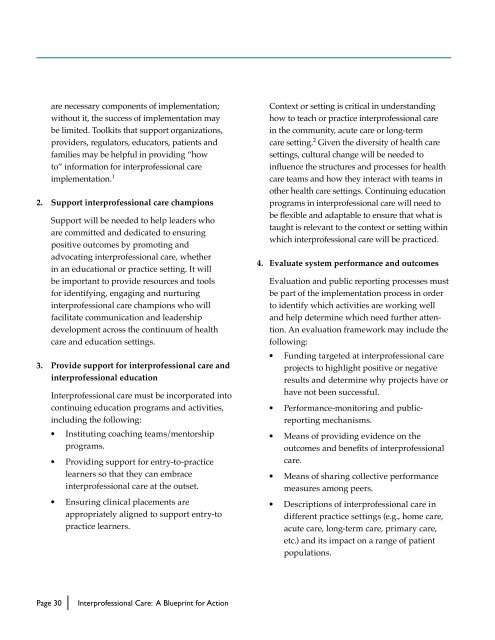Interprofessional Care: A Blueprint for Action - HealthForceOntario
Interprofessional Care: A Blueprint for Action - HealthForceOntario
Interprofessional Care: A Blueprint for Action - HealthForceOntario
Create successful ePaper yourself
Turn your PDF publications into a flip-book with our unique Google optimized e-Paper software.
are necessary components of implementation;<br />
without it, the success of implementation may<br />
be limited. Toolkits that support organizations,<br />
providers, regulators, educators, patients and<br />
families may be helpful in providing “how<br />
to” in<strong>for</strong>mation <strong>for</strong> interprofessional care<br />
implementation. 1<br />
2. Support interprofessional care champions<br />
Support will be needed to help leaders who<br />
are committed and dedicated to ensuring<br />
positive outcomes by promoting and<br />
advocating interprofessional care, whether<br />
in an educational or practice setting. It will<br />
be important to provide resources and tools<br />
<strong>for</strong> identifying, engaging and nurturing<br />
interprofessional care champions who will<br />
facilitate communication and leadership<br />
development across the continuum of health<br />
care and education settings.<br />
3. Provide support <strong>for</strong> interprofessional care and<br />
interprofessional education<br />
<strong>Interprofessional</strong> care must be incorporated into<br />
continuing education programs and activities,<br />
including the following:<br />
• Instituting coaching teams/mentorship<br />
programs.<br />
•<br />
•<br />
Providing support <strong>for</strong> entry-to-practice<br />
learners so that they can embrace<br />
interprofessional care at the outset.<br />
Ensuring clinical placements are<br />
appropriately aligned to support entry-to<br />
practice learners.<br />
Page 30 <strong>Interprofessional</strong> <strong>Care</strong>: A <strong>Blueprint</strong> <strong>for</strong> <strong>Action</strong><br />
Context or setting is critical in understanding<br />
how to teach or practice interprofessional care<br />
in the community, acute care or long-term<br />
care setting. 2 Given the diversity of health care<br />
settings, cultural change will be needed to<br />
influence the structures and processes <strong>for</strong> health<br />
care teams and how they interact with teams in<br />
other health care settings. Continuing education<br />
programs in interprofessional care will need to<br />
be flexible and adaptable to ensure that what is<br />
taught is relevant to the context or setting within<br />
which interprofessional care will be practiced.<br />
4. Evaluate system per<strong>for</strong>mance and outcomes<br />
Evaluation and public reporting processes must<br />
be part of the implementation process in order<br />
to identify which activities are working well<br />
and help determine which need further attention.<br />
An evaluation framework may include the<br />
following:<br />
• Funding targeted at interprofessional care<br />
projects to highlight positive or negative<br />
results and determine why projects have or<br />
have not been successful.<br />
•<br />
•<br />
•<br />
•<br />
Per<strong>for</strong>mance-monitoring and publicreporting<br />
mechanisms.<br />
Means of providing evidence on the<br />
outcomes and benefits of interprofessional<br />
care.<br />
Means of sharing collective per<strong>for</strong>mance<br />
measures among peers.<br />
Descriptions of interprofessional care in<br />
different practice settings (e.g., home care,<br />
acute care, long-term care, primary care,<br />
etc.) and its impact on a range of patient<br />
populations.





